● ● ●
NOTE ON NOMENCLATURE
Panzer was the word
generally associated with the armored forces of the German
Army. The armored branch of service was called the
Panzerwaffe—literally, armored weapon.
Panzerkampfwagen—literally
armored battle vehicle—was
the German word for tank, often abbreviated to
Panzer
when
referring either to tanks in general or specific models,
e.g. the Panzer II light tank. It was also used to denote
units, e.g. Panzer-Abteilung
(armored battalion). For more information, see the
Glossary of
German Military Terms.
● ● ●
Germany’s defeat in World War I was
the chief determining factor in that country’s military
development from 1919 to 1939. The Treaty of Versailles
imposed severe restrictions on the size and capabilities of
the German armed forces—the
Reichswehr. Military
aircraft, heavy artillery, tanks and frontier fortifications
were all prohibited and caps were imposed on numbers of
other weapons; on the naval side submarines were prohibited
and the overall size of the fleet was severely limited.
The 100,000-man army of the Weimar
Republic—the Reichsheer—was thus reduced to the
status of an internal security force. But these worrisome
and humiliating restrictions on German military power had
one advantage. By eliminating the vast wartime arsenal
that the victorious powers were free to maintain, the Peace
Treaty cleared the way for fresh approaches based on the
experiences of the war. The officers of the Reichsheer,
carefully selected for retention in service, were regarded
as the architects of future military power when the moment
came, as almost all Germans hoped it would, for the “Shame
of Versailles” to be renounced.
Prominent among lessons these officers
pondered in the 1920s was the impact of mechanization on
warfare. The Allies’ large-scale
employment of tanks in the
war’s concluding phase had played a major role in the defeat
of the German Army, and it was clear that future rearmament
plans must include them. Thanks, however, to the
restrictions of the Peace Treaty it was almost impossible to test
concepts of armored warfare in the field. But though tanks
were forbidden, motorization of the existing arms of the
service was not, and it was in the transportation branch of
Reichsheer that the first experiments along those
lines was conducted.
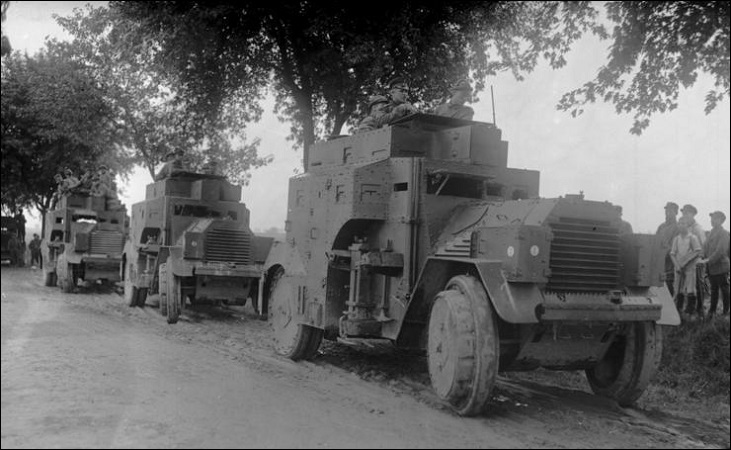
Wheeled troop carriers like these were
the only armored vehicles allowed to the Reichheer.
They could also be employed as armored cars with one or
two machine guns mounted. Vehicles of this kind were
used to conduct early field tests of armored combat
tactics. (Bundesarchiv)
The key figure was Heinz Guderian. In
World War I he had served as a signals officer, an infantry
company and battalion commander and finally as a General
Staff officer, finishing the war as a captain. In 1919 he
was among those officers selected for retention in the
Reichsheer. In the early 1920s he became interested in
armored warfare tactics; his first mentor was Ernst
Volckheim, a brother officer who had served in the wartime
Army’s small armored corps. After the war Volckheim was
posted to the Kraftfahrtruppen (transport troops) and
in 1925 he was appointed as an instructor at the Army
officer school in Dresden, specializing in armored warfare
theory. Beginning in 1923 Volckheim’s articles on the
subject appeared frequently in the Militär Wochenblatt
(Military Weekly), an influential professional
journal, whose editor he became in 1927.
Without doubt, Volckheim’s writings
and teaching strongly influenced the development of
Guderian’s own ideas. Through him, the future panzer leader
also became acquainted with the theories of the
British tank
prophets, especially J.F.C. Fuller and B.H.
Liddel Hart, and with the experiments in mechanization
carried out by the British Army in the 1920s. Some
historians credit Volckheim with the concepts that Guderian
later so forcefully advocated. Others have charged that his
postwar memoir, Panzer Leader, exaggerates Guderian's
role in the creation of the German Army’s new armored
branch: the Panzerwaffe. Be that as it may,
Guderian's contributions to the development of armored
warfare doctrine were significant. It was he, for example,
who insisted that every tank should be equipped with a
radio, an innovation that gave the panzers a significant
edge over their opponents in the first phase of World War
II.
Up to 1922 Guderian, an infantry
officer by training, commanded a company in a Jäger
(light infantry) battalion. In that year he was transferred
to the transport section of the Truppenamt (Troops
Office), as the Reichsheer central staff was titled.
To provide him with some practical experience beforehand, he
was attached on temporary duty to a company of the 7th
(Bavarian) Motor Transport Battalion in Munich, at that time
commanded by Major Oswald Lutz. After that he began his work
in the transport section—still, as he remarks in his
memoirs, with very little practical experience to guide him.
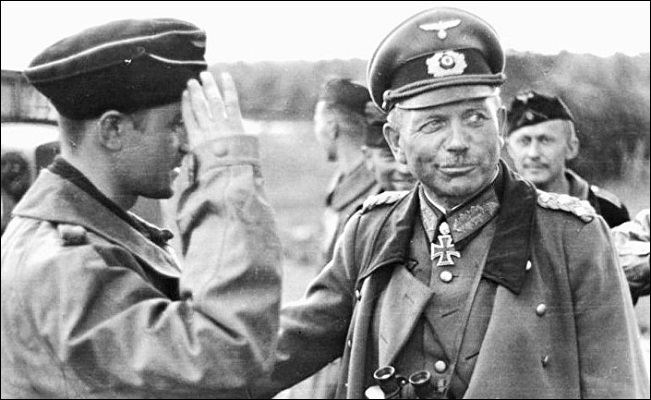
Prime architect of the
Panzerwaffe: Colonel-General
Heinz Guderian (right) on the Eastern
Front in 1941, at which time he was
commander of the Second Panzer Group (Bundesarchiv)
The Inspector of Transport Troops at
that time was one Major-General von Tschischwitz, described
by Guderian as a highly critical superior who noticed the
slightest mistakes and laid great stress on accuracy:
“Working for him was good training.” One of the Inspector’s
projects was the preparation of a study on the movement of
combat troops by motor vehicles and it was this, Guderian
tells us, that first awakened him to the military potential
of motorization. Between 1922 and 1928 his studies gradually
convinced him of the viability of mechanized warfare, and
the concept of the panzer (armored) division, a mechanized
force with tanks as its centerpiece, gradually took shape in
his mind.
Though the theoretical writings of
British and German military thinkers certainly played a role
in Guderian’s thinking, the lessons of the First World War
were of equal importance. The question was how tanks fitted
into the larger tactical picture, and here the German Army’s
1917-18 infantry tactics offered a solution. The wartime Army’s
elite Stoßtruppen (assault
troops) were formations combining infantry armed with light
and heavy machine guns, trench mortar detachments, and
combat engineers equipped with demolition charges and
flamethrowers. Operating in platoon or company strength the
Stoßtruppen
led the attack, bypassing defensive strongpoints, striking
toward the enemy’s vulnerable rear area. It
was this concept—that of the integrated battle group
employing infiltration tactics—that would be followed when
the first panzer divisions were set up in 1935.
In 1929 Guderian, by now a major, was
asked by the Chief of Staff to the Inspector of Transport
Troops, Colonel Oswald Lutz, whom he’d first met in 1922, if
he would like to command a motorized battalion. Guderian
seized upon this opportunity and was duly appointed
commander of the 3rd (Prussian) Motorized Transport
Battalion, which was stationed in the Berlin area. With
Lutz’s support, he set about converting it into a motorized
reconnaissance battalion. Of its four companies, one was
equipped with armored troop carriers, one with motorcycles, one with
dummy tanks and one with dummy towed antitank guns. Here at
last was an opportunity to test the concepts that up to now
had been confined to the realm of theory. “With this very
improvised unit,” he remarks in his memoirs, “I now
proceeded to concentrate on field exercises.” Their results
convinced Guderian that he and the Army’s other tank
enthusiasts were on the right track—and the time was coming
soon when their ideas would be enacted on a large scale.
In 1931 Guderian was promoted to
lieutenant-colonel and made chief of staff to Major-General
Lutz, now the Inspector of Motorized Troops. From that point
forward he would play a major role in the development of the
Panzerwaffe. The two men forged an effective
partnership. Guderian functioned as the public advocate of
mechanization, a role to which he was temperamentally well
suited. Lutz worked mostly behind the scenes, intervening
from time to time to smooth the ruffled feathers produced by
his chief of staff’s forceful, occasionally tactless
personality. Events now moved quickly. The Nazi Party came
to power in January 1933, and the new chancellor, Adolf
Hitler, soon made it clear that he intended to denounce the
disarmament provisions of the Treaty of Versailles and
rebuild German military power.
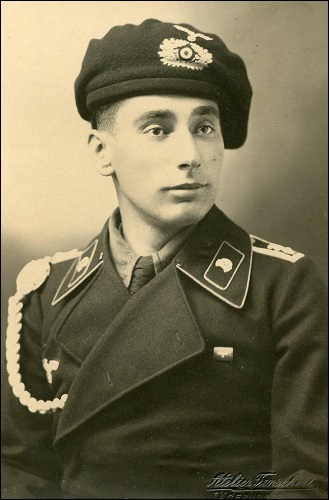
A prewar portrait photograph of a German
soldier wearing the special black uniform introduced for
panzer troops in 1934. On duty, a crash helmet was worn
under the beret. Due to its black color and death's head
collar badges this ensemble was often mistaken for an SS
uniform. (Giel's Militatia)
It must not be thought that every senior
officer of the German Army embraced the concepts of
mechanized warfare advocated by Guderian and others. As in
all armies, the current of conservatism ran strong and
though most acknowledged the value of the tank as a support
weapon, there was considerable skepticism over claims that
it heralded a revolution in the art of war. In his memoirs,
Guderian recounts various examples of the opposition he
encountered. General Ludwig Beck, the Chief of the General
Staff, was cold to the idea of panzer divisions; he believed
that the largest tank formation should be the panzer
brigade, organized to support the infantry. Considerable
opposition was also put up by the Cavalry Inspectorate,
which viewed the Panzerwaffe as an unwelcome rival
and succeeded in getting authorization for four so-called
light divisions. These were conceived as successors to the
old horse cavalry divisions with all units motorized,
including a single panzer battalion. Guderian complained
that the light divisions lacked punch and wasted resources
that could instead have been used to set up more panzer
divisions—points ultimately conceded when they were
converted to panzer divisions in 1939-40.
Given the opposition that its
proponents encountered, the creation of the Panzerwaffe
was a considerable achievement—and it owed a great deal to
the support received from Hitler, a man who in those days at
least was receptive to new ideas. Visions of blitzkrieg—a
word never officially adopted by the Army—enthralled him,
especially as it seemed to accord with the dynamic
self-image of National Socialism. “That’s what I want!
That’s what I have to have!” he exclaimed when tanks were
demonstrated for him in the mid-1930s.
By that time Guderian, Lutz and their
collaborators had settled on the form of the future panzer
divisions. At their core would be a panzer brigade of four
battalions with a total of some 400 tanks. These would be of
two types: light and medium. The former was to be armed with
a 37mm main gun and two machine guns; the latter with a 75mm
gun and two machine guns. The panzer battalions would each
have three companies with light tanks and one with medium
tanks. The infantry contingent would consist of a motorized
rifle regiment of two battalions plus a separate motorcycle
infantry battalion under a brigade headquarters. The
divisional organization was completed by an artillery
regiment of two battalions with 12 x 105mm howitzers each, a
reconnaissance battalion, an antitank battalion, an engineer
company, a signal battalion, and the division trains—all
motorized.
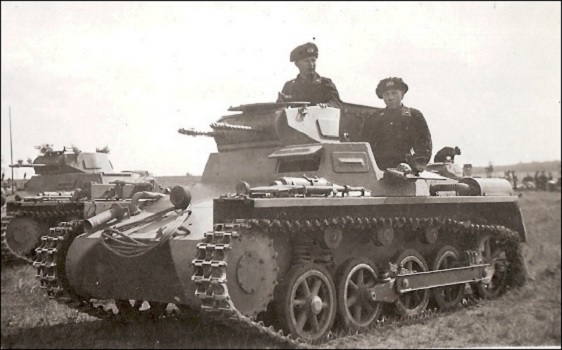
The Panzer I was intended to serve as
a training tank pending the availability the Panzer III
and Panzer IV, but had to be committed to combat in the
first phase of World War II. The crew members are
wearing the special black uniform introduced for panzer
troops. (Bundesarchiv)
The requisite tanks existed as
prototypes, the Army in cooperation with industry having
carried out clandestine development work since the mid-1920s
both in Germany and abroad. But they required further
refinement, particularly regarding radio and optical
equipment, before entering series production. As an interim
measure, the Carden-Loyd military tractor, designed for the
British Army, was modified to serve as a training tank. It
was armed with twin machine guns in a revolving turret and
entered production as the Panzer I. When ongoing design and
production problems further delayed the desired light and
medium tanks, another interim design was approved: the
Panzer II, armed with a 20mm automatic cannon and one
machine gun. The Panzer III (37mm gun) and the Panzer IV
(75mm gun) only began rolling off the production lines in
1936-37—initially in small quantities.
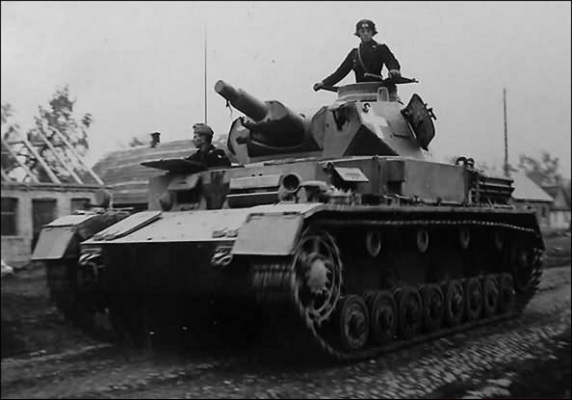
The Panzer IV. This early model (Ausf.
B) was armed with a 75mm L/24 gun plus two
machine guns. A total of 42 were produced in
1938-39. The white cross on the turret was a
recognition sign, applied to armored vehicles for
the Polish campaign. (Tank Encyclopedia)
In 1936-37, at Lutz’s suggestion,
Guderian wrote and published Achtung! Panzer!—a
book recounting the development of armored warfare theory in
Germany and describing how the panzers were to be employed
in action. The book’s polemical tone and vivid imagery fired
the imagination of some within the Army and irritated
others—a pattern that was to be repeated over the course of
the author’s subsequent career.
For Germany, the years 1935-38 were
both politically and militarily portentous. The significant
military developments were the establishment of a Motorized
Troops Command Staff under General Lutz (1934), Hitler’s
denunciation of the disarmament provisions of the Treaty of
Versailles and his subsequent decree on rearmament (1935),
and the activation of the first three panzer division in
that same year. The command of the 2nd Panzer Division was
given to Colonel—soon to be Major-General—Heinz Guderian.
Later he was promoted to lieutenant-general and given
command of the XVI Army Corps, in which the panzer divisions
were concentrated. He and his troops participated in the
Austrian Anschluss, the occupation of the Czech
Sudetenland, and finally the occupation of Czechoslovakia
itself (1938).
On the eve of World War II Guderian
was serving as Inspector-General of Mobile Troops. By then
there were five
panzer divisions in existence and the conversion
of the light divisions was about to begin. For the invasion
of Poland General of Panzer Troops Heinz Guderian, as he was
by then, received command of the XIX Army Corps with one
panzer division and two motorized infantry divisions. In the
Polish campaign the Panzerwaffe,
with the Luftwaffe’s ground attack aircraft operating in
close support, proved devastatingly effective against
a gallant but outclassed opponent. The ideas that Guderian,
Volckheim Lutz and others had championed for a decade thus
proved themselves in the crucible of battle.
● ● ●